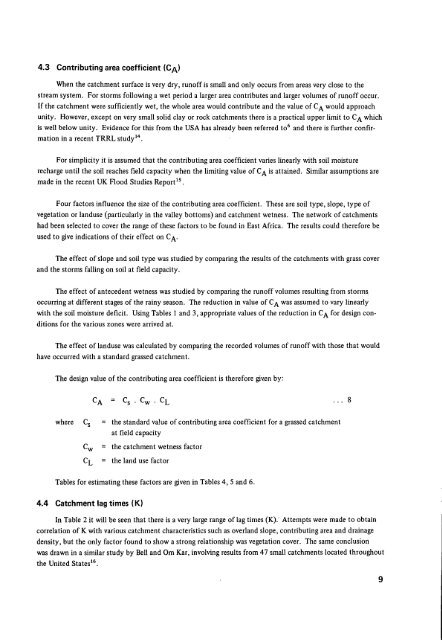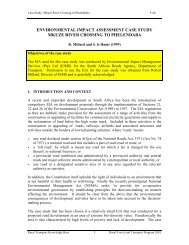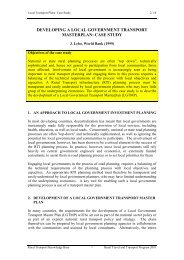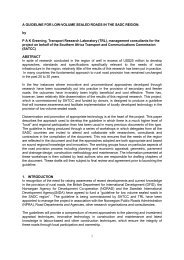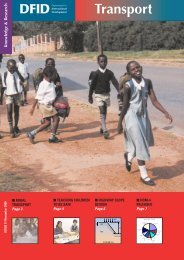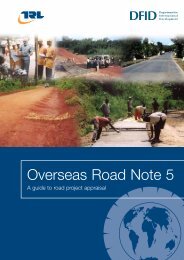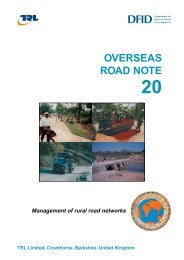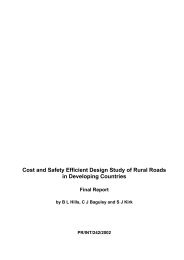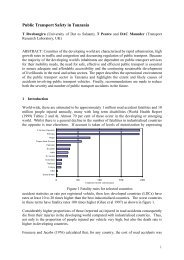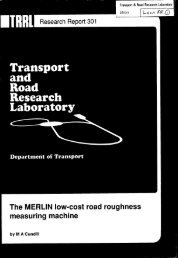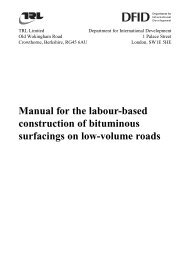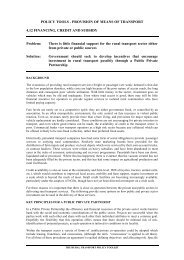LR706 East African Flood Model_ Fiddes - Transport for Development
LR706 East African Flood Model_ Fiddes - Transport for Development
LR706 East African Flood Model_ Fiddes - Transport for Development
You also want an ePaper? Increase the reach of your titles
YUMPU automatically turns print PDFs into web optimized ePapers that Google loves.
4.3 Contributing area coefficient (CA)<br />
Wen the catchrnent surface is very dry, runoff is small and only occurs from areas very close to the<br />
stream system. For storms following a wet period a larger area contributes and larger volumes of runoff occur.<br />
If the catchment were sufficiently wet, the whole area would contribute and the value of CA would approach<br />
unity. However, except on very small solid clay or rock catchments there is a practical upper limit to CA which<br />
is well below unity. Evidence <strong>for</strong> this from the USA has already been referred to6 and there is further confirmation<br />
in a recent TRRL study 14.<br />
For simplicity it is assumed that the contributing area coefficient varies linearly with soil moisture<br />
recharge until the soil reaches field capacity when the limiting value of CA is attained. Similar assumptions are<br />
made in the recent UK <strong>Flood</strong> Studies Report15.<br />
Four factors influence the size of the contributing area coefficient. These are soil type, slope, type of<br />
vegetation or Ianduse (particularly in the valley bottoms) and catchment wetness. The network of catchments<br />
had been selected to cover the range of these factors to be found in <strong>East</strong> Africa. The results could there<strong>for</strong>e be<br />
used to give indications of their effect on CA.<br />
The effect of slope and sod type was studied by comparing the results of the catchments with grass cover<br />
and the storms falling on soil at field capacity.<br />
The effect of antecedent wetness was studied by comparing the runoff volumes resulting from storms.<br />
occurring at different stages of the rainy season. The reduction in value of CA was assumed to vary linearly<br />
with the soil moisture deficit. Using Tables 1 and 3, appropriate values of the reduction in CA <strong>for</strong> design conditions<br />
<strong>for</strong> the various zones were arrived at.<br />
The effect of landuse was calculated by comparing the recorded volumes of runoff with those that would<br />
have occurred with a standard grassed catchment.<br />
The design value of the contributing area coefficient is there<strong>for</strong>e given by:<br />
CA ‘es. cw. cL . . . 8<br />
where Cs = the standard value of contributing area coefficient <strong>for</strong> a grassed catchment<br />
at field capacity<br />
Cw = the catchment wetness factor<br />
CL = the land use factor<br />
Tables <strong>for</strong> estimating these factors are given in Tables 4,5 and 6.<br />
4.4 Catchment lag times (K)<br />
In Table 2 it will be seen that there is a very large range of lag times (K). Attempts were made to obtain<br />
correlation of K with various catchment characteristics such as overland slope, contributing area and drainage<br />
density, but the only factor found to show a strong relationship was vegetation cover. The same conclusion<br />
was drawn in a similar study by Bell and Om Kar, involving results from 47 small catchments located throughout<br />
the United States16.<br />
9


